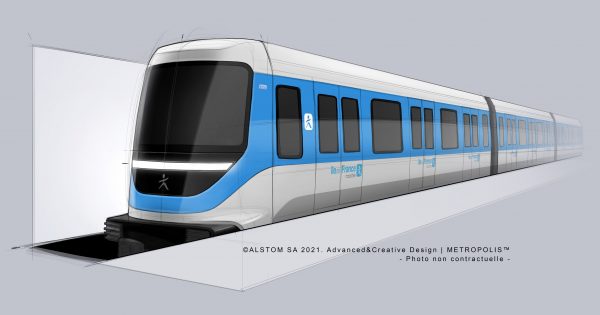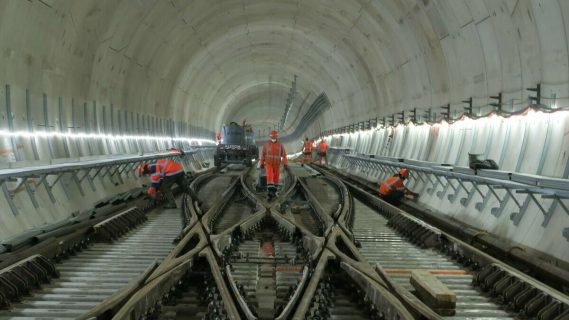The latest
Alcatel Lucent Enterprise (ALE) and Nokia have been appointed to provide connected network solutions for Grand Paris Express’s new lines.
According to the contract, the two communications companies will maintain and operate video surveillance and air quality across a high-speed backbone network and IoT sensors. As a distribution partner for Nokia, ALE, will install its ruggedized LAN OmniSwitch range across stations and in remote industrial environments. Nokia on the other hand will provide its multi-service IP/MPLS high-speed backbone network to the metro lines.
Speaking on the project, Nathan Stenson, vice president of Nokia’s Global Partner Channel, said that this state-of-the-art technology enables a powerful multi-service IoT network that provides air quality and video monitoring in stations with 13,000 cameras and AI to enhance safety and security.
Grand Paris Express Project Overview

Grand Paris Express is a modern rapid transit being constructed in the Île-de-France in France.
The development includes four new lines for the Paris Métro and extensions of the current Lines 11 and 14. Around 200 kilometres (120 mi) of additional tracks and 68 new stations are to be developed. This will enable the entire system to serve a projected 2 million daily passengers.
A total of €35.6 billion has been earmarked for the Grand Paris Express project, including a provision of €7 billion for risks and contingencies.
Importance of the Grand Paris Express
It’s a project of the century in the whole of Paris, and a scheme to give the Paris conurbation and infrastructure system commensurate with growing momentum and objectives.
The Grand Paris Express lays down Paris firmly in the 21st century: after the development in the 20th century of metro and RER regional express lines all extending out from the capital’s centre.
Read also: The Melbourne Metro Tunnel Project Timeline
The project’s aim is to develop a new ring network that permits suburb-to-suburb travel without having to go through the centre of Paris and also offers direct links to the airports. The project will bring significant benefits to the many residents who work or live in areas which were not well served by public transport.
Another aim of the new system is to limit urban sprawl around the city by densifying already urbanized parts that will now be linked to the heart of the conurbation and will gain from urban upgrading schemes around the new stations.
Grand Paris Express Project Timeline
2013
Considered one of the most ambitious sustainable mobility schemes in the world, the new public transport network was launched in 2013 and set for completion in 2030.
The scheme called for the extension of the existing lines and the development of four new lines, the 15, 16, 17, and 18. Line 15 runs in a large circle around the suburbs of the city, the huge urban agglomeration that makes up Greater Paris, while lines 16, 17, and 18 will link other suburbs and municipalities outside Paris city.
In September, The Artemis consortium founded by engineering firms Arcadis, Artelia, and BG Ingénieurs Conseils agreed on a 16-year €40m ($50m) contract with SGP to be the main project manager and oversee the development operations for Lines 15, 16 and 17.
2014
In October, Société du Grand Paris (SGP) awarded the design tender for the Le Bourget station to Elizabeth & Christian de Portzamparc (AECDP). Miralles Tagliabue and Bordas + Peiro were also awarded contracts for Line 16, Clichy-Montfermeil station.
2015
The Grand Paris Express construction started.
The SNC-Lavalin consortium won a project management services tender from Société du Grand Paris (SGP) for Line 18 later in September.
2016
Work began for the extension of Line 14 near Saint-Lazare station, the Paris metro’s second most congested. In accordance with the timeline set by the developers, by 2018 the line would be able to offer the passage of new trains with eight rather than six cars, raising the capacity to 40,000 passengers per hour.
The ICARE consortium was selected for the infrastructure design and supervision contract for Line 18 in February.
2020

Around 20 Herrenknecht tunnels and boring machines (TBMs) were in operation simultaneously. Out of the 20, 16 were EPB shield machines with diameters ranging from 7725 mm to 9840 mm, 3 TBMs for variable density of 7710 mm to 9830 mm diameters, and one vertical shaft sinking machine with diameters between 8300 mm and 11 900 mm.
On second October 2020, the President of Île-de-France Mobilités, Valérie Pécresse and of the Île-de-France Region, Thierry Dallard, Chairman of the Management Board of the Société du Grand Paris, and the Chairman and CEO of Alstom Henri Poupart-Lafarge, disclosed the design of the future metros for new lines 15, 16 and 17 of Île-de-France at the inauguration of the exhibition Les lignes du design (Design Lines).
2021
In accordance with the city administration’s ideas, Line 4 of the Metro, in the southern region of the city, will be extended by a couple of kilometres with the development of two new stations. Currently, the line stops at Montrouge, a banlieue in the south of the city, while the extension will bring it to Bagneux, even further south.
Line 4, which runs through the city from north to south, and Line 12 will also get extension work in the southern area including the construction of two stations.
November 2021
Laurence, one of the ten tunnel boring machines (TBM) working on the 33km Grand Paris Express Line 15, bored through two stations and three service structures on the route, as well as under the Seine River, to breakthrough at Fort d’Issy-Vanves-Clamart station.
Grand Paris Express Line 15 which extends from Île de Monsieur shaft at Sèvres to the Noisy-Champs station, is one of four new metros lines being developed by Société du Grand Paris with CAP group, a Vinci Construction joint venture as the contractor.
The 9.87m diameter Laurence TBM was launched in January 2020 and has excavated 323,400 m3 of material during the 4.2km drive from the Île de Monsieur shaft at Sèvres.

December 2021
VINCI Construction through its subsidiaries Chantiers Modernes Construction and CBI was awarded by Société du Grand Paris a contract to upgrade Noisy-Champs station, which upon completion will link the future Line 15 South and Line 16 with RER Line A.
Straddling Noisy-le-Grand (in Seine-Saint-Denis) and Champs-sur-Marne (in Seine-et-Marne), the station will have two monumental timber helixes, one emerging from each city, converging into a spiral at the top.
The project scope of the project involves structure, masonry, technical and architectural trades, roads, utilities, and landscaping.
April 2022
The first breakthrough at the future Clichy-Montfermeil station of metro line 16 made
The tunnel-boring machine (TBM) “Mireille” made its first breakthrough at the future Clichy-Montfermeil station of metro line 16 being constructed in northern Paris as part of the Grand Paris Express, Europe’s most ambitious future mobility project.
Mireille arrived at the station to the applause of the mayors of Clichy-sous-Bois and Montfermeil, representatives of the client, Société du Grand Paris, after boring 2.2 kilometres from the Bel-Air site in Chelles at the southern end of Lot 2 – the section of the line under development by Webuild and NGE.
It was a significant milestone for the project, which Webuild and NGE shared with the locals of Clichy-sous-Bois on a large TV screen near the construction site. Guglielmina Fontana, the site’s construction manager, followed the breakthrough in the company of 50 female workers.
Mireille will soon resume its voyage for another 3.1 kilometres, passing through the municipalities of Livry-Gargan and Sevran on its way to the Mare au Chanvre site in Sevran, where it will meet “Houda,” the TBM excavating from Lot 2’s northern end.
Scope of the Webuild and NGE Works
Webuild and NGE are creating 11 kilometres of tunnels for Line 16 as part of the Grand Paris Express, as well as four stops between Aulnay-sous-Bois and Chelles.
They have already finished another project together: Lot 4 of Line 14 South, which runs 4.1 km to Orly Airport in Paris’s south. Lot 2 of Line 16 and Lot 4 of Line 14 South will help remove up to 385,000 cars from Paris’ streets each day, preventing up to 81,000 tonnes of CO2 emissions each year. By 2050, Paris hopes to be carbon neutral.
Line 16 will convey an estimated 200,000 passengers each day in the Paris department of Seine-Saint-Denis. The other three stations to dot the line include Aulnay, Sevran-Beaudottes and Sevran-Livry.
The Grand Paris Express will add 200 kilometres of metro and light rail to the French capital’s network, with 68 stops, to improve connectivity between the centre and the periphery. It is intended to boost the local economy, create jobs, encourage sustainable mobility, and minimize automobile traffic and air pollution.
Webuild is a major contributor to the development of urban and extra-urban mobility, supporting attempts to lower traffic and pollution by offering safe, efficient, and environmentally friendly public transportation services. Webuild has a combined track record of over 13,600 kilometres of rail and metro lines over more than a century.
With a portfolio of over 20 references on the Paris transport network, including three major underground projects on lines 11, 14, and 15, NGE will lead the construction of railway equipment on line 16 through its railway subsidiary TSO, demonstrating its multi-disciplinary expertise in delivering sustainable mobility projects.
Jul 2022
Grand Paris Express project: Work Progresses on Lines 16 and 17
A new milestone has been reached on the Grand Paris Express project.
The first half of the Line 16 tunnel between Saint-Ouen and Aulnay has been completed. A total of four tunnel boring machines (TBMs) completed the work. This has enabled engineers to begin preparing sections of Lines 16 and 17 for future metro operations.
At the beginning of June this year, teams from the TSO consortium began laying rails and sleepers on a common section of the two lines between Saint-Denis Pleyel station and the Finot structure.
The rails will reportedly be made by Saarstahl of 95% recycled steel. The company produced the rails through an electric arc furnace. It used recycled steel and scrap, rather than a coal-fired blast furnace. This process is said to have reduced carbon emissions by 60%.
The laying of the rail lines will be followed by the installation of the catenary, electrical cables, lighting, signage, and ventilation systems. Work is also underway to install a total of 850 meters of double tracks.
Furthermore, a crossover that will enable the trains to be turned around in the Finot structure will also be installed. This is necessary because it will enable the trains to travel in the opposite direction, as the lines end at Saint-Denis Pleyel.

